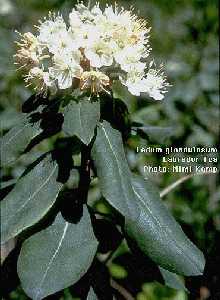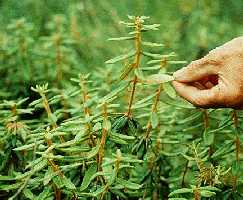

 Jump to Page Navigation buttons===>
Jump to Page Navigation buttons===>Lots of people, many kids, on northern reservations here and west into Montana, can show you what they call "swamp tea" though there are two different plants that different kids will show you. Only one of these is what was the traditional swamp tea, Muskeegobug, Ledum glandulosum, or Laborador Tea as its main common English name. The other was known as Odigadimanido, a special gift of the spirit or Manido powers. That's Ceanothus ovatus, or New Jersey Tea in its common English name. |
|---|
| Swamp tea or Muskeeg Anibi, botannically named Ledum glandulosum, common name Laborador Tea, is found from Greenland to the Rockies, and Northwest coast. In Minnesota it doesn't usually flower this big. This tea grows everywhere in the north, a weed 1 - 3 feet tall. Most reservation people know about it. It contributes vitamins and minerals, contains both thyeine and caffeine for a pick-up and to still that coffee craving. Tea can be made from crushed green leaves. |  |
|---|---|
 |
Here's a swamp tea plant (not in bloom) from around this area.Dried to keep (which few seem to do any more) it is best gathered when the plant's in flower (late July, August), and dried in the shade. Its Ojibwe name, Muskeegobug Aniibi, translates directly as "Swamp-growing" tea. The word "muskeg" has entered English, meaning northern swamps. |
|
That's Ledum groenlandicum just above, ometimes called Laborador tea because it flourshes in long snowy winters, comparatively cold wet conditions. It's known, found, dried and drunk by tribal people all over the Anishiinabeg range, and I've heard that they like it as far nmorth as it grows. This plant's leaves contain both caffein and tannin. On White Earth when some was brought over, I was told "When we can't afford coffee, we can always get this." | |
|
This is ledum palustrium, another variety which seems to flower more showily than we see around here. Its leaves are perpendicular to the stem -- like Groenlandicum -- but are narrow- rolled at the edges, and darker green. This variety of "Indian tea" grows in the west, in drier areas whose winters are warmer. |
 |
|
Around here, the ledum is known as "the real swamp tea" but another plant is also referred to as "the other swamp tea." | |
 | Ceanothus ovatus, common name New Jersey tea, is called in Ojibwe Odigadimanido, top gift from the Manido powers. No use trying to look at a big photo. Herb Foundation's big JPEG is damaged. I extracted this picture full-size from part that was undamaged. |
|---|---|
| You can see the characteristic curving leaf ribs quite well here. This tea (leaves picked when flowering, July here, dried in shade) tastes most like Oriental tea of any, but it contains no thyeine or caffeine; it isn't a stimulant. It is medicinal but the use there is 5 " of the dried root grated, boiled in a pint of water, with a small dose (one spoonful for respiratory problems). Name and dosage both indicate the medicine is powerful and shouldn't be fooled around with. But the leaf tea is just a nice-tasting tea from a common plant. Its range is much wider (further south) than swamp ta and it like sandy, gravelly soil and full sun; it is easier to find among roadside weeds. | |
| The powerful name given to this plant by Ojibwe women indicates the great regard it was once held in as a medicinal tea. There is nothing in any analysis of the plant to suggest why this might have been, and no one I know remembers any more anything about preparation (of roots, rather than the leaves). Dried leaf tea (and crushed green) are drunk now just as a good-tasting tea that may be easier to get at -- grows in more accessible places -- than the ledums.
It actually tastes very close to ordinary store-bought Chinese (green, unsmoked). But the one-time medicinal use from which it its powerful name is derived seems to have vanished in time with the women who once knew the proparation and uses. New Jersey leaf tea is popularly drunk by hikers and others all across the US. and Canada. Perhaps this is a vague remnant of its once-known medicinal powers, perhaps it only means that it tastes good and is easy to find. | |

Custom Search
|
 RECIPE RECIPE Page |
 PLANTS PLANTS Page |
|---|
CREDITS: Most photos from Michael Moore's images database. You'll be looking at the main subdirectory, which contains some instructions. In each subdirectory are pix of plants whose scientific botannical names begin with those letters. An HTML file within each of those subdirectories further ID's the plants. To use this database you must know the plants' scientific, botannical names. Several photos on this page were taken by Mimi Kamp for Michael Moore's image database. TheCeanothus JPEG is damaged; it does not load properly but a cropped section shows plant ID characteristics. The ledum groendladicum species (with a man's hand for size comparison) is the type that grows around here. That photo is from the University of Wisconsin Botany gopher.
Last Updated:Wednesday, December 27, 1995 - 11:20:18 PM